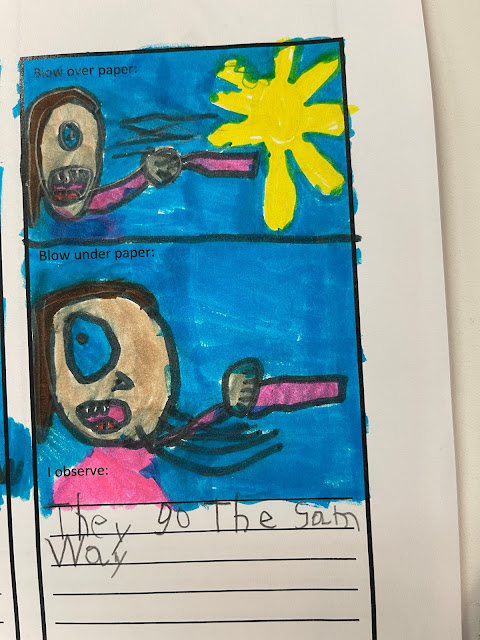In our quest to discover how man can fly, the Navigators actually have the chance to think like several scientists.
Instead of just giving the answer, we go through the process.
Here is our process and our reasoning.
The students' amazing thinking is in quotation marks.
~~~~~~
Thinking like Leonardo da Vinci:
Leonardo was observant.
We take a close look at Velcro work to see how it works like burrs stuck in a dog's fur?
(We took several days to look at biomimicry.)
Leonardo drew what he saw.
We draw maple tree seeds from different angles and have fun watching them fall.
Leonardo was a dreamer. He dreamed that man would one day fly.
We make paper models of one of his drawings - a helicopter.
Leonardo experimented.
We add paper clips weights to see what happens.
We come up with more and more experiments.
We even drop paper to watch how a leaf falls.
What if we drop a flat "helicopter"?
Leonardo was curious: How do birds fly?
We are curious, too.
How do birds fly?
How do heavier things fly?
~~~~~~
Thinking like Bernoulli:
We start with a question.
How do birds fly? "I think it's magic."
He might be on to something!
"I think it flies by its wings' shape and the feathers on the wings."
"I think the birds' bones are hollow, which allows them to flap and twist their wings while they fly. Flap, twist, flap, twist, flap, twist. They twist their wings while they fly."
What happens when you blow between two balloons?
"They move together when they are blown with air."
"They hug."
"When you blow the balloon, it goes to the other balloon."
"The candle moves towards the blow!"
"I observe that when you blow, it comes toward you."
"When the straw is next to the flame, it will bring the flame to it."
"The flame likes the straw."
What happens when you blow under a strip of paper and then blow over the strip of paper?
"They both go the same way."
"I was surprised that when I blew on top of the paper it went up."
What happens when you blow down through a spool with a piece of paper under it?
"When you blow in, it sucks the paper."
"The wind is blowing it on the spool."
"The air held the paper up so that the gravity would not pull down the paper."
~~~~~~
Putting it all together:
How does this all work together?
Why?
How?
Bernoulli's Effect, the flow of air, the shape of the wing, and lift!!
We watch several videos including this one
Gravity, thrust, lift, and drag
Light bulb moment!
This student explains it well:
"Lift is what pulls a bird or an airplane up into the air."
We might not totally get it, but our light bulbs are becoming less dim and more bright.
And we're thinking like scientists!





















































